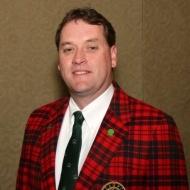Greg Muirhead is a senior designer at Rees Jones, Inc. and a past president of the American Society of Golf Course Architects. Muirhead joined Rees Jones, Inc. in 1984 upon graduating from Ball State University. Among his notable projects are Ocean Forest Golf Club in Sea Island, Georgia; Nantucket Golf Club in Nantucket, Massachusetts; Sandpines Golf Club in Florence, Oregon; and 3 Creek Ranch Golf Club in Jackson Hole, Wyoming.
are Ocean Forest Golf Club in Sea Island, Georgia; Nantucket Golf Club in Nantucket, Massachusetts; Sandpines Golf Club in Florence, Oregon; and 3 Creek Ranch Golf Club in Jackson Hole, Wyoming.
I was fortunate to know I wanted to be a golf architect very early in my life. My friends recall me doodling golf holes during seventh-grade social studies class.
Unfortunately, my professional career was almost derailed before it ever got started. While completing my landscape architecture degree in 1982, I consulted with Pete Dye at Crooked Stick Golf Club, which was then my home course, about how to break into the golf course design business. Pete was kind enough to offer me a summer internship position participating in the construction of his new Austin Country Club project in Austin, Texas.
Having completed all necessary arrangements and having received all appropriate approvals from my school administrators, I secured housing in Austin, and arrived on site after a two-day drive from Indianapolis, ready to learn.
I quickly located Pete’s on-site project architect, Rod Whitman, and introduced myself. The long silence and look on Rod’s face made it clear he had no idea who I was, or why I was there! It seems Pete had neglected to let Rod know that help was on the way.
Rod made it clear he didn’t need any interns, but eventually agreed to give me a week to “see what happens.” I worked very hard that week, and I was very relieved when Rod agreed to let me stay for the summer, as well as to return the following summer to participate in the course completion and grow-in.
After graduation, I worked for Rod on another of Pete’s courses in Denver, Colorado before Alice Dye, Pete’s wife, helped me secure my current position.
One of my first big projects was the design of the Charleston National Golf Club in Mt. Pleasant, South Carolina. The sandy site, featuring a blend of towering pines and century-old live oaks, was bordered by a tidal marsh and panoramic water views of the Isle of Palms. At the time, it was one of the most naturally diverse and scenic parcels of property I’d ever seen. The club itself was conceived as a very high-end and exclusive facility, with a course intended to both challenge and impress its national membership. After the considerable efforts and expense of many, the course was completed and set to open in absolutely pristine condition.
Two days prior to opening, Hurricane Hugo and its accompanying, fifteen-foot-high storm surge swept across the site. As a kid in Indiana, I’d seen tornado damage; however, the overwhelming devastation I witnessed when touring the course a few days after the storm was beyond my comprehension and very disheartening.
While conducting a site evaluation trip in St. Lucia, my potential client suggested we tour the site via helicopter. I agreed and he proceeded to make the appropriate arrangements. After taking my seat in front, the pilot began to remove the door on my side.
“An unobstructed view will provide you with the best ‘feel’ for the property,” he said.
After some inner-reflection, I went along with him. As I began adjusting my headset, I noticed the pilot encapsulating the latch of my seat belt buckle in duct tape. This state of the art safety precaution was intended to keep me from inadvertently bumping the latch and falling out of the plane. Before I could protest, we were airborne and I was enjoying one of the most exhilarating site tours I’ve ever encountered.
One of the most rewarding projects I’ve been associated with was the restoration of the East Lake Golf Club. In this case, golf functioned as something significantly more than just a game.
Local philanthropist and developer Tom Cousins purchased the club, in the early 1990’s. Mr. Cousins had the vision to use the game of golf as the vehicle to attract and combine both public and private resources in a landmark effort to revitalize an entire community and change lives. Today, the East Lake community is a proven success, featuring new, mixed-income housing, a neighborhood charter school, a YMCA, the Charlie Yates public golf course, and various outlets. Hopefully, this model will be replicated in communities throughout the country.
